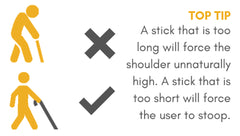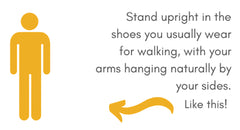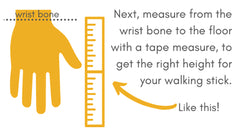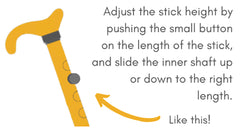Free delivery on orders over £50, only £4.95 under £50
Free delivery on orders over £50, only £4.95 under £50
Welcome to our blog, your one-stop resource for news, features and resources for living life to the fullest. View our articles on the latest mobility products and features with disability bloggers.
Posted by Jan Payne on June 14, 2020

Photo by Ljupco from iStock
First Things First – Choosing Your Stick
You may have been advised to use a walking stick to aid your mobility, or have decided for yourself that you could walk more easily with a little more support, but with such a large choice of sticks available, how do you go about choosing the right one for you?
The first thing you should do is look at what’s available. To see our full range, please click here. Then, use our handy guide to help you work out what type of walking stick you, or your loved one needs. There are wooden walking sticks, aluminium sticks, adjustable and non-adjustable walking sticks, sticks that give you even more support with more than one base, colourful patterned sticks (if you want to stand out!), folding and non-folding sticks, straight or swan-necked walking sticks – we even have sticks with a seat! It’s enough to make your head spin!
There are several things to consider when you’re looking for the perfect walking aid.
The grip, or handle, is possibly what defines your choice of walking stick the most. Your needs will dictate what type you choose. Do you have arthritis in your hands? If you do, we have just the thing for you here. If you’re unsteady on your feet and need extra support, look at our extra-stability walking sticks. If you are likely to put a lot of pressure on the handle, an offset handled cane with a soft grip might be best.
Take heart, there will be a walking stick that is perfect for you and it is very likely that Ability Superstore will have it!
Wood, or Aluminium?
Traditional wooden walking sticks are strong, good looking canes with a full choice of right, or left hand, comfort, or arthritis grips. They come in a range of attractive woods, such as chestnut, ash, hazel and oak, and a choice of many different colours – they are long-lasting, too. They are ideal, as they can also be sawn to exactly the right length.
Aluminium sticks are lighter, more easily adjustable for height, are extremely strong and come in folding, non-folding, extra stability formats, as well other handle, or grip options. Most aluminium sticks are easily adjusted for height, with clips, or buttons, usually spaced 2.5cm (1 inch) apart. Some fold, or collapse, so if you don’t need to use a stick all the time, you can fold it up and carry it in a bag, or on your belt. There are several different accessories available for walking sticks including replacement ferrules, folding stick carry bags, clips to keep the walking stick balanced on a nearby top, or table, folding stick clips to hold a folding walking stick together when it is collapsed, walking stick wrist straps, to keep the stick close at hand and a whole lot more. To see the full range click here.
The majority of walking sticks have rubber ferrules on the tip to provide extra grip when in use.
The next thing to do is…
Measure and Adapt the Stick to Suit You
Now you’ve chosen a walking stick with a comfortable handle, the next thing to do is make it just right for you.
Wooden sticks usually come in a standardised length – but people don’t – so a little care is needed to ensure yours is adapted exactly right. Aluminium sticks are easily adjustable through a series of e-clip style pop-out clips, usually in 2.5cm (1 inch) increments.
Wooden walking sticks need a little more attention, but both styles need to be measured and adjusted. If this is your first stick, we thought you might welcome a few tips about the best way to adjust and use a walking stick, because it’s not as straight forward as you might think.
Let’s start with the stick’s length. If your stick is too long, your shoulder will be too high and your elbow will stick out, preventing you from putting pressure on the handle for support, this means you could end up with aching shoulders and neck.
If your stick is too short, you’ll bend forward too much, or possibly lean over to one side. You’d likely hurt your back, or your shoulder, even your hips, too!
Whether too long, or too short, an incorrect stick length will put too much pressure on your joints causing pain, affect your posture and could cause both back and shoulder problems.

Humans vary so much in height – the length of our arms and legs, even the height of the heels on our shoes will have an effect. The length of your walking stick should therefore reflect your own individual height.
If you decide that a wooden stick is best for you, this is how to get the perfect length. It will help if you can get someone else to do the actual measuring.
Wear your most comfortable walking shoes and stand as upright as you can, but still relaxed, with your feet together and your arms straight down by your sides.

A measurement should be taken from the floor, about 15cm (6 inches) out from your ankle to your wrist bone – which is why you need a helper, as it’s difficult to stand straight and measure yourself at the same time! This will ensure your wrist is at the perfect comfort position when holding your stick, with your arms slightly bent and shoulders level.

Measure again just to make sure, then mark that measurement on the stick, measuring from the top of the handle down the shaft towards the tip. Then saw it level at that point with a small hacksaw.
Don’t forget to take off the rubber ferrule from the cut end and replace it back onto your shortened stick. In time, the ferrule will wear down, but this is easily replaced.
For aluminium height adjustable walking sticks, use the in-built mechanism to adjust the stick by pushing the small button on the stick shaft. Then, slide the inner shaft up, or down, to the correct length and release the button into the correct hole. Some walking sticks have an external “e-clip” instead, so for these, just remove the e-clip, align the two halves of the shaft to the correct height and pop the e-clip back in.
We've put together another blog that you may find helpful – How To Use and Adjust Folding Walking Canes. You can read it, if you click on this link.

Just One Last Thing...
It might seem strange at first, but it’s normal to have the walking stick on your ‘good leg’ side. Try it that way first, but if that doesn’t feel natural after you have used it for a time, and you are more comfortable with the stick by your weakest leg, it’s fine to use it that way.
With your stick touching the ground next to you, the arm holding it should be slightly bent at the elbow, not straight and locked. The stick should be placed forward at the same time as the affected leg, and then the unaffected leg follows.
If you need two sticks for walking, place one stick forward – then the opposite leg – then the other stick – then the other leg i.e. four separate actions.
If you’re using a multi-point stick for extra stability, all points of the stick should be in contact with the ground when the stick is in a forward position.
When you go upstairs, lift the unaffected leg up first, then raise the walking stick and weaker leg up to the same step. Going downstairs, the stick and weaker leg should go first, then the good leg lowered to the same step.
That’s it, you’re done! Happy walking everyone.
If you do have any questions, please don’t hesitate to call our customer service number free on 0800 255 0498 – we’re here to help.